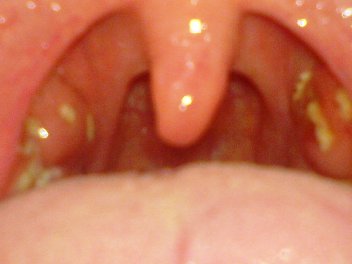Summary
– Diagnosis of angina
– Principle of treatment of angina
– Treatment of bacterial angina with antibiotics
– Treatment of viral angina with antibiotics
The initial diagnosis essentially determines the approach proposed by allopathic medicine to treat angina. Determining the origin of the sore throat is fundamental to deciding whether or not a prescription of antibiotics is proper.
Diagnosis of angina

Diagnosis is made using a rapid diagnostic test (RDT) that provides a reliable result less than five minutes.
This type of test is rarely performed in children under three years of age, who only infrequently develop bacterial angina.
In the event of a group A strep throat suspicion, the doctor can prescribe antibiotic therapy if the RDT performed in the pharmacy reveals a case of streptococcus.
Principle of treatment of angina
Bacterial angina (25 to 40% of angina in children and 10 to 25% of angina in adults) can be treated with antibiotics, unlike viral angina, for which antibiotic therapy is ineffective.
Prescribing antibiotics only to:
– avoid generating bacteria resistant to treatment (ecological advantage);
– limit the number of unnecessary side effects (personal benefit);
– avoid inappropriate public health expenditures (economic benefit).
Treatment of bacterial angina with antibiotics
Introduction
Antibiotic treatment of bacterial angina can be started and remain effective for up to nine days after the first symptoms appear.
Bacterial angina is treated with amoxicillin (penicillin) for six days at a rate of:
– 2 g per day divided into two doses for adults;
– 50 mg per kilogram per day in two doses for children.
Other solutions such as cephalosporins or macrolides are available.
It is essential to respect the doctor’s treatment duration, even if the symptoms improve rapidly. However, if they persist after two or three days of treatment, the patient should be re-examined.
Good to know: pharmacists can dispense without prescription the following antibiotics for the treatment of odynophagia in patients aged 6 to 45 years: Amoxicillin PO, Cefuroxime-Axetil PO, Cefpodoxime-Proxetil PO, Azithromycin P0, Cefotiam hexetil PO, Clarithromycin PO, and Josamycin PO.
Treatment
Bacterial angina usually resolves spontaneously. However, patients are asked to follow the antibiotic treatment prescribed for several reasons carefully:
– to accelerate the disappearance of the symptoms: the treatment allows to gain 24 hours;
– to avoid contagion: the contagious aspect disappears after 24 hours of treatment;
– to completely eradicate the bacteria: the bacteria must not become resistant to antibiotic treatment.
Good to know: according to some experts, it would be more beneficial for the patient to stop his antibiotic treatment as soon as he feels better. In addition, this would not promote antibiotic resistance, reducing overall consumption of antibiotics!
Note: Please, check with your doctor before stopping any prescribed medication.
Treatment of viral angina with antibiotics
Introduction
Antibiotics should not be used in viral angina, regardless of the virus involved, because it does not do the job perfectly: it will only reduce the symptoms to relieve angina and improve the patient’s comfort.
Rest, along with analgesics (drugs to reduce pain) and antipyretics (to reduce fever), is recommended.
Treatment
A maximum of five days’ treatment should be observed. To obtain an analgesic and anti-inflammatory action, one can use:
– A collutory, i.e., a medication dedicated explicitly to problems affecting the mouth and throat. Generally in a dab, but there are also sprays for greater convenience.
– A local anesthetic will effectively reduce the pain.
– Paracetamol is frequently used for its analgesic action as well as for its antipyretic effect.
Hope this post has been informative to you. Kindly remember to drop your comments below.



Pingback: Sugar And Its Alternatives – Hello sites
Pingback: Focus On Complementary Health Care For A Young Unemployed Person – Hello sites